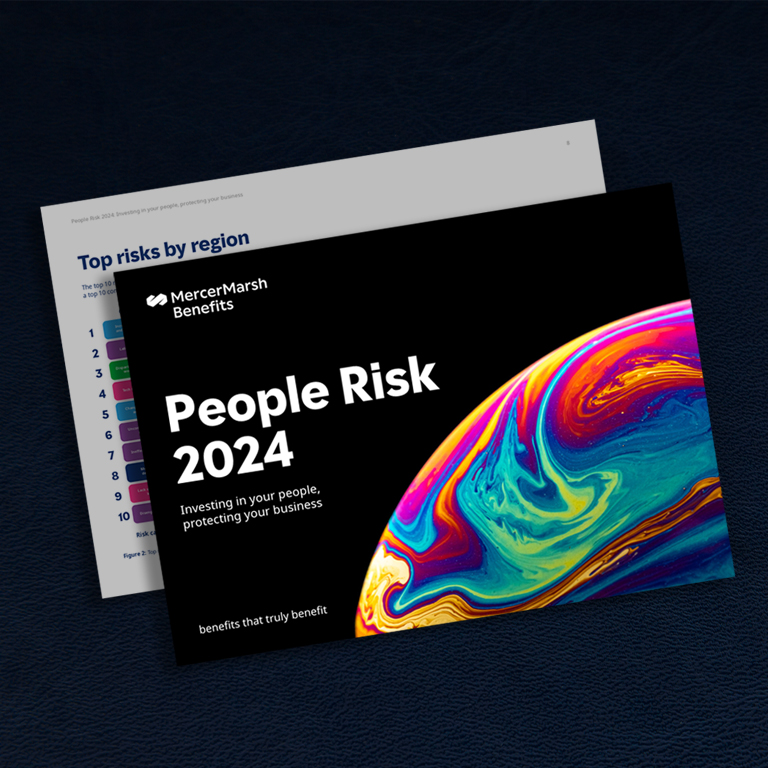
Despite recognizing the significant operational threats posed by poor health and safety, there are signals of fatigue in managing health risks. Successful businesses need healthy workers, so firms must not be complacent and should ensure that well-being is a top strategic priority.
Health and safety is a major people-related threat facing organizations, according to risk managers and HR professionals in the People Risk Report 2022. In addition, our Global Talent Trends research showed that 36% of executives have seen measurable returns from their investment in health and well-being[1]. Business leaders are now more aware of the business implications of failing to create a culture of health in the workplace.
This is not surprising—the spread of COVID-19 clearly demonstrated that a firm stands and falls on the well-being of its people. Three years of a pandemic have forced organizations to think carefully about health and safety, with many implementing new programs and initiatives designed to protect the workforce and keep businesses running. It’s now time to take a step back, reflect and reset these programs to incorporate learnings. We’ve been inspired by benefit managers across multiple industries who are re-setting benefits by relevance, incorporating advancements in:
- Digital health and benefits access and adoption; in the UK, for example, virtual care has shifted from being an add-on available at an extra cost to a standard part of employer-sponsored packages
- Importance of prevention and well-being including social and emotional health; around the world, we are seeing interest from employers in better understanding how the workplace impacts mental health and the role the employer and colleagues can play in maintaining it
- Techniques for listening to employees and other data analyses to understand needs as well as root causes of issues; for example, in the areas of health inequities and mental health
However, the People Risk Report 2022 suggests that businesses are perhaps becoming complacent when it comes to managing and mitigating future health and safety risks. We found that concerns such as mental well-being and workforce exhaustion ranked low when it comes to risk rating scores (likelihood of the risk occurring over a three-year horizon multiplied by the severity, according to HR and risk managers). Yet, the mental health crisis brought on by the pandemic is well-documented and those organizations with poor mental well-being support may find that valued employees prefer the caring attitude promoted by competitors.
Key global findings in the People Risk Report 2022
- Pandemics and other communicable health conditions took the top spot in the Health and Safety category from a risk rating score perspective. There continues to be concern regarding the spread of COVID-19, but also over the risk of other infectious illnesses.
- The unmanaged risks from sub-optimal employee health and well-being programs and a rise in non-communicable health conditions like obesity, hypertension, diabetes, lung disease, and cancer create further exposures and took the second spot in this category. If poorly managed, these will lead to higher costs and weaker organizational performance. Some employers operating in high employer-sponsored medical cost locations (for example, the US) are getting ahead of this by developing cancer care-specific strategies. The prominence of well-being in the employee value proposition is increasing, resulting in attraction, retention, and engagement issues if not properly managed.
- The pandemic has caused deteriorating mental health, with more people than ever suffering from anxiety, stress, depression, and addiction. In the first year of the COVID-19 pandemic, the global prevalence of anxiety and depression increased by 25%, according to a scientific brief released by the World Health Organization (WHO)[2]. The business impacts can be severe, including low productivity, escalating benefits spend, and damage to employment value proposition and brand. Across all 25 people risks, this risk dropped from the number six spot last year to number 22 this year. We are concerned that HR and risk managers feel this has been appropriately mitigated, whereas the fact is that continuous focus is needed.
- Similarly, workforce exhaustion appears to be a blind spot given multiple individual and societal factors including work-life balance issues, intensification of work, change fatigue, and too many priorities and distractions. This often leads to errors, high employee turnover, reduced productivity, and even damaged reputation.
- Rounding out this category is work-related illness or injury, including accidents, unsafe exposure, security incidents, or aggravation of pre-existing conditions in a work environment (whether onsite or remote), all of which can carry severe legal, financial, and reputational consequences.
Trends to watch
The critical importance that employer-sponsored group life, disability, and medical schemes play in people’s lives should not be underestimated. Important health issues are not going away. Employers can play a critical role in helping to meet UN Sustainability Goal #3: Ensure healthy lives and promote well-being for all at all ages[3] This includes a goal to achieve universal health coverage, including financial risk protection, access to quality essential healthcare services, and access to safe, effective, quality, and affordable essential medicines and vaccines for all.
HR and risk managers respectively ranked mental health 18th and 21st out of 25 risks and workforce exhaustion 22nd out of 25. This is quite stunning considering that these are such pervasive issues, and it seems at odds with intersecting risks that did make it into the top 10, including catastrophic personal life events, changing nature of work and the environment.
We are concerned that mental health is being viewed as “last year’s problem” and that employers feel they have “checked the box” by adding an EAP or running an anti-stigma campaign. The global need for mental healthcare remains a challenge worldwide. The prevalence of mental disorders is rising globally and places a burden on society that needs to be addressed as the issue continues to grow, work continues to intensify, cultures lack inclusiveness and access to necessary mental health support is poor.
What firms can do
Recent crises such as pandemic, violent conflicts, natural disasters, and climate events have highlighted the importance of having a range of mental health supports in place during moments that matter. Some geographies (for example, the UK) are introducing legislation to better prepare for terrorist attacks, including the support needed following an attack.
Broader workforce health needs to be a partnership between the employer and employee. In addition to providing valued support, employers must consider well-being when they design jobs and set working conditions.
Ideas to get started
- Complete a well-being program benchmarking system and individual/organizational health risk assessment to obtain recommendations in areas such as organizational/cultural support for well-being, program scope, and participation strategies and to start building a multi-year workforce health strategy.
- Seek out and assess aggregated anonymized employee health profile data to understand organizational health profiles.
- Implement strategies to identify and manage psychosocial risk factors; psychosocial hazards relate to how work is organized, social factors at work, and aspects of the work environment, equipment, and hazardous tasks—ISO standard 45003 is a good place to start[4].
- Inventory and assess employee support programs in place (including grassroots efforts), focusing on those that cover physical, emotional, social, and financial well-being.
- Engage all levels of business leaders in order to create a culture of health and well-being (including demonstrative business support, internal role models/champions, healthy workplaces, and health-related policies/procedures).
- Make sure a full range of mental health supports are in place, covering prevention to treatment.
- Set minimum standards for basic medical coverage and assess gaps in public/private health schemes.
- Gauge employee interest in newer types of supports covering areas such as parenting, social networking, proactive musculoskeletal health, substance abuse, and preventive genetic testing.
- Challenge business leaders on how “ways of working” impacts workforce health (e.g., the pace of technology change).
Conclusion
If health and safety risks are not managed, they have the potential to lead to misconduct, safety accidents, and other problems; when successfully managed, however, mitigations can support ESG goals, diversity, equity, and inclusion, as well as enable a thriving, energized workforce capable of the creative processes needed for business success.
Rigorous management of health and safety risks has helped many organizations continue business operations during the pandemic. While companies should stay vigilant in monitoring health and safety indicators including absenteeism, workforce stress levels, rotation, accident rates, temporary hiring, work conflicts, premium costs, and litigation activity, we also urge them to consider the broader impact that workforce health programs and healthy cultures have on productivity, engagement, and quality of life. As executives are incented by factors other than financial performance, the social roles that benefit programs and support for employees along their unique health journeys can play in advancing healthy societies should not be underestimated.
[1]Mercer. Global Talent Trends Study, 2022. Available at www.mercer.com/our-thinking/career/global-talent-hr-trends.html.
[2]World Health Organization.2022. COVID-19 pandemic triggers 25% increase in prevalence of anxiety and depression worldwide. Available at https://www.who.int/news/item/02-03-2022-covid-19-pandemic-triggers-25-increase-in-prevalence-of-anxiety-and-depression-worldwide
[3]United Nations. (2020, September 19). Take Action for the Sustainable Development Goals. United Nations Sustainable Development. Available at https://www.un.org/sustainabledevelopment/sustainable-development-goals/
[4]International Organization for Standardization. (2021, June). ISO 45003:2021 Occupational health and safety management — Psychological health and safety at work — Guidelines for managing psychosocial risks. Available at https://www.iso.org/standard/64283.html
Our People


Dr. Ariel Almazan
Related insights

Report
People Risk 2024
04/23/2024

